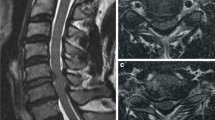Abstract
Background
The unilateral biportal endoscopic (UBE) technique is less invasive and has a faster recovery time than open surgery. Compared with the uniportal technique, the biportal technique has a larger field of vision and a wider operation range.
Method
We attempted the posterior UBE approach for cervical stenosis at the C4–C6 levels. UBE decompression of C4–C6 with unilateral lateral mass screw fixation at the C4–C5 levels was performed under general anesthesia.
Conclusions
We successfully performed cord decompression at the C4–C6 levels using the UBE technique. This approach could be used as an alternative method to treat cervical stenosis with instability.





Similar content being viewed by others
References
Magerl F, Grob D, Seemann P (1987). Stable dorsal fusion of the cervical spine (C2-Th1) using hook plates[J]. In: Kehr P, Weidner A (eds) Cervical spine I. Springer, New York, pp 217–221. https://doi.org/10.1007/978-3-7091-8882-8_38
Song KS, Lee CW (2020) The biportal endoscopic posterior cervical inclinatory foraminotomy for cervical radiculopathy: technical report and preliminary results [J]. Neurospine 17(Suppl 1):S145–S153. https://doi.org/10.14245/ns.2040228.114
Su N, Fei Q, Wang BQ, Kang N, Zhang QM, Tang HH et al (2019) Comparison of clinical outcomes of expansive open-door laminoplasty with unilateral or bilateral fixation and fusion for treating cervical spondylotic myelopathy: a multi-center prospective study. BMC Surg 19:116. https://doi.org/10.1186/s12893-019-0583-8
Wang M, Luo XJ, Deng QX, Li JH, Wang N (2016) Prevalence of axial symptoms after posterior cervical decompression: a meta analysis. Eur Spine J 25:2302–2310. https://doi.org/10.1007/s00586-016-4524-2
Funding
This work was supported by the National Key R&D Program of China (2019YFC0121400).
This study protocol was approved by the Research Ethics board in our hospital. The patient signed a written informed consent form that she will be enrolled in this study.
Author information
Authors and Affiliations
Corresponding author
Ethics declarations
Conflict of interest
The authors declare no competing interests.
Additional information
Key points
• We successfully performed total laminectomy for cervical stenosis with unilateral lateral mass screw fixation using a biportal endoscopic posterior approach.
• The benefits of the endoscopic approach included the preservation of the paraspinal muscles and ligaments, a minimal amount of estimated blood loss, fast postoperative recovery, and a short hospital stay.
• The portals were designed based on the lesion site, and the endoscopic instruments moved across the surface of the lamina; thus, two incisions were sufficient for multilevel decompression.
• Imaging data should be analyzed meticulously, and the course of the vertebral artery and any aberrant anatomy should be recognized.
• Dissection should not exceed the lateral margin of the lateral mass; otherwise, significant bleeding can occur, obscuring the operation field.
• A 2-mm diamond burr can be used to locate the screw entry points under fluoroscopy.
• It is slightly difficult to insert the rod into the polyaxial screws under endoscopy, and more patience is needed.
• The locking nuts can be implanted with the aid of a hemi-cannula to ensure that the locking nuts are not lost in soft tissue.
• Unilateral and bilateral lateral mass screw fixation can produce similar results in terms of cervical curvature maintenance and clinical outcomes [3].
• The dorsal cortex of the lamina can be removed with a grinding drill, and the ventral cortical bone can be carefully removed with a 1-mm Kerrison rongeur to ensure that the cord is not injured.
Publisher’s note
Springer Nature remains neutral with regard to jurisdictional claims in published maps and institutional affiliations.
This article is part of the Topical Collection on Spine degenerative
Supplementary Information
Below is the link to the electronic supplementary material.
Supplementary file1 (MP4 282793 KB)
Rights and permissions
About this article
Cite this article
Zhu, C., Deng, X., Pan, H. et al. Unilateral biportal endoscopic laminectomy with lateral mass screw fixation for treating cervical spinal stenosis. Acta Neurochir 164, 1529–1533 (2022). https://doi.org/10.1007/s00701-022-05212-y
Received:
Accepted:
Published:
Issue Date:
DOI: https://doi.org/10.1007/s00701-022-05212-y




